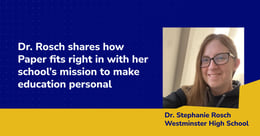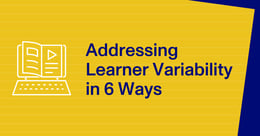
Teachers talk: The best strategies to drive student motivation
Many teachers thrive off of facilitating lively discussions and fostering lightbulb moments, but these inspiring exchanges don’t just spring up spontaneously. Educators make intentional choices that spur students’ motivation.
[READ: “Teachers share the tangible—and intangible—rewards of the job”]
We talked with teachers from around the country to explore what strategies they use to keep learners tuned in every day.
Read on to find out what they said.
When students experience success, they acquire drive
Broadly speaking, there are two types of motivation that students can tap into with the help of their teachers: extrinsic and intrinsic motivation. Extrinsic motivation refers to factors that come from the outside, like grades or praise. Intrinsic motivation, on the other hand, comes from the inside. Intrinsically motivated students are driven by self-directed attributes such as curiosity, interest, and a sense of achievement.
[READ: “6 tips to maximize motivation in K-12: Tapping into student engagement”]
Lissa Teston of Harnett County Schools in North Carolina believes that skillful teachers can support students in moving from extrinsic to intrinsic motivation by helping them develop a sense of accomplishment.
“You start with the candy and the stickers and the little prizes, and then you lead up to that internal incentive,” said Teston. “They want to feel that success more and more, and once they get that little taste, they keep working for that.”
In this way, building up a student’s sense of confidence can help lead them toward a self-sustaining cycle of intrinsic motivation.
The ability to exercise choice is a powerful motivator
To support students’ innate sense of agency and ownership over their lives, some teachers focus on maximizing choice. That’s what Jamie Marie Wilson of Texas’ Mesquite Independent School District says she does in her high school classroom, with one exception: Students don’t have the choice to not work.
“At that age, their adults are in charge of everything,” said Wilson. “We love a good choice board!”
[READ: “10 student-directed learning exercises to try with Paper™”]
Wilson infuses choice everywhere in her classroom. Small opportunities for students to exercise their agency can have a big impact on motivation during everyday activities, just as large-scale opportunities for learners to pursue their own curiosities can help them persevere and follow through on longer-term academic goals.
For example, as Clay Hale of East Side Union High School District in California explained when describing how he helps students connect their studies to life outside the classroom, learners in his class get to select their own focus for an important project.
“For our classes, we do a five-page paper their senior year called their senior civic action project, in which they identify a problem in their community and try to solve it through policy and the real-world application of that,” said Hale.
Even when student choice isn’t at the forefront of these assignments, several other teachers echoed that project-based learning can be very valuable for getting students motivated.
Real-world relevancy leads to greater enthusiasm
It’s difficult to get excited about learning when students don’t have a sense of why they’re studying something in the first place. Teachers can support learners in focusing on long-term goals by helping them find their purpose and by clarifying the links between learning and life.
Like Hale, Florida educator Lizzette Leborgne values project-based learning.
“I’m a true advocate when it comes to project-based learning,” said the School District of Palm Beach County teacher. “It’s something that belongs to them, and it’s pertinent, and when we do that in class, you can see the motivation—you can see the integration.”
[READ: “The K-12 guide to student-centered learning”]
In the ELA classroom, Alexandra Pantastico of the J.O. Combs Unified School District in Florida shared how her selection of class materials helps students connect literature to the world around them.
“We read a lot of historical novels and realistic fiction, and we always have conversations—or they have writing—about how it relates to either their personal life or to what is happening in the world today,” said Pantastico.
Positive peer relationships drive engagement
Healthy peer relationships are a great source of connection and belonging. Both collaborative encouragement and friendly competition can be strong motivators for K-12 students.
Pick a partner!: Kudos and paired activities
There are few things more gratifying than feeling seen—especially by one’s peers. That’s why positive interactions between classmates can be so motivating.
“They’ll cheer each other on,” said Lacy Snelling of Nevada’s Washoe County School District. “They look for their peers to appreciate what they’ve accomplished.”
Teachers can cultivate opportunities for meaningful interaction early on in the learning process too. For many learners, the chance to work together with their friends feels like an immense privilege.
“I like to do a lot of cooperative learning where the kids are working in groups, and I think that motivates them to do a task,” said Jennifer Welch of Nevada’s Clark County School District.
Ashley Bebow, who teaches in Michigan’s Hemlock Public School District, has a similar perspective.
“Anytime they can work with a partner—especially of their choice—that also tends to motivate them to work through the tasks that you give them,” said Bebow.
[READ: “Building confidence: Ashley Bebow on Paper’s impact in her classroom”]
The value of games: Incentive, competition, and play
Injecting some playfulness into the classroom can make students forget they’re even learning in the first place. This can take several forms.
For instance, a simple game format can liven up review sessions and everyday lessons while serving as a reward for positive behavior. And remember, games don’t have to be overly complicated to be effective.
“Aside from all the computer games, we’ll just take the trash can and some paper basketballs, and if they get it right they get to shoot,” said Nicole Bobby of New York’s Pine Bush Central School District. “I think just bringing ‘trashketball’ into the classroom is enough to get anyone excited.”
[READ: “7 tips to blend game-based activities with other teaching strategies”]
Besides serving as a reward for positive actions and productive behavior, games have another advantage when it comes to motivating students: competition. Teachers from a wide variety of grade levels acknowledge the value of competition—when deployed in a safe and friendly environment—to help spur students to give their best.
“I find my students love competition,” said David Long, who teaches an Advanced Placement®* history course in Boston Public Schools.
Additionally, exploring new topics or reviewing old material through exciting and interesting games adds an element of playfulness that can provide variety and a sense of fun, making the learning process more rewarding in and of itself.
Melinda Evans of Mississippi’s South Tippah School District described the enthusiasm generated by one such game her students seem to love
“They get to hack and take money, and the kids are like, ‘Oh, I got your money!’” said Evans. “Before they can go to the next level, they have to answer a question. So they’re learning at the same time.”
Trust from adults—inside and outside the classroom—helps students persevere
In addition to connecting with their peers, students can derive a great deal of resolve from positive relationships with teachers and other adults who care about their well-being.
Teachers: Urging students forward through connection and positive regard
Helping students see why a particular topic is important can be an effective way to drive motivation, but sometimes it takes time. In these situations, mutual trust between teachers and their students can serve as a bedrock to build on.
“When I’m teaching them math, I can’t say how they might use it, because they don’t even know what they’re going to do,” said Whitney Van Lierop of Georgia’s Gwinnett County School District. “But if they know I care—and I’m saying this is what we’ve got to work on—that, to me, is what I’ve seen motivate my kids.”
Alyssa Kotovsky, of Hillsborough County Public Schools in Florida, agreed.
“It goes back to that relationship and listening to them and finding things in their interests—and them knowing that they can count on you to support them,” said Kotovsky.
Rebecca Gaynon of California’s South San Francisco Unified School District added that a teacher’s authenticity and enthusiasm can go a long way toward making these relationships feel real, meaningful, and enriching.
“Across the hall from me, there's a math teacher, and so many of the math problems he comes up with, he makes it about him—he's preparing a meal, and how many rolls are needed if this many people are sitting at this many tables?” said Gaynon. “If we're really excited about what we're teaching, I think that brings up the motivation level.”
Reducing perceived risk: Lowering the stakes to asking for help
On the flip side, sometimes students can be afraid of disappointing the adults in their lives. Vulnerability is scary, and having an outside individual they can turn to for academic support can mean the difference between forging ahead or throwing up their hands.
“Part of what paralyzes us is fear,” said Molly McDonald of Boston Public Schools. “If it’s math, fear of solving the problem incorrectly and having done all that work for something that’s wrong—with a paper, fear that what I’m writing isn’t good enough.”
McDonald said that Paper’s Live Help is an example of the kind of solution that allows students to seek assistance without fear.
Dr. Victoria Lindemann of Clark County School District also sees the value in students having the opportunity to connect with supportive adults who don’t have any preconceived notions about who the learner is or what they’re capable of.
“They don’t have to impress that outside source,” said Lindemann. “I think the asset of Paper is to give that extra hand to say, ‘Hey, you’re doing OK right now. How about looking at this portion?’”
Lindemann said her students find feedback from Paper’s Review Center to be manageable, allowing them to quickly take positive action and to keep moving forward.
Promoting confidence for lifelong learners
The teachers we spoke with had no shortage of wisdom to share. We learned a lot about how to keep students engaged on an everyday basis—as well as over the long term—and we’re excited to share their perspectives so even more students can benefit from these inspiring insights.
Looking for more ways to keep your learners tuned in? Check out our free ebook “5 ways student-centered interventions can increase engagement.”
* AP® is a trademark registered by the College Board, which is not affiliated with, and does not endorse, this website.





.jpg?width=260&height=136&name=Educator-Voices-Laura-Ashley-Lavery%20(1).jpg)
